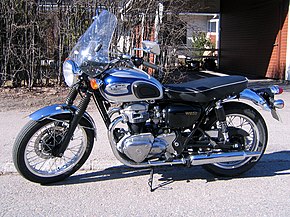 2000 W650 in "Galaxy Silver/Luminous Boralis Blue" | |
| Manufacturer | Kawasaki |
|---|---|
| Also called | Kawasaki W400 |
| Production | 1999–2007 |
| Successor | W800 |
| Class | Standard |
| Engine |
|
| Bore / stroke | 72 mm x 80 mm |
| Compression ratio | 8.6:1-8.7:1[2] |
| Top speed | 180 km/h (110 mph)[3] |
| Power | 50 PS (37 kW; 49 hp) at 7,000 rpm[2] |
| Transmission | 5-speed, chain |
| Rake, trail | 24° 108 mm (4.3 in)[4] |
| Wheelbase | 1,455 mm (57.3 in) |
| Dimensions | L: 2,180 mm (86 in) W: 790 mm (31 in) H: 1,075 mm (42.3 in) |
| Seat height | 790–800 mm (31.1–31.5 in) |
| Weight | 430 lb (195.0 kg)[3] (dry) 476 lb (215.9 kg)[3] (wet) |
| Fuel capacity | 15 L (3.3 imp gal; 4.0 US gal) |
The Kawasaki W650 is a retro standard motorcycle marketed by Kawasaki for model years 1999–2007. It was superseded by the Kawasaki W800.
The "W" in "W650" refers to Kawasaki's W1, W2 and W3 models, manufactured between 1967 and 1975.[3] The "650" refers to the engine displacement.
In 1999, superseding the Zephyr series, Kawasaki introduced the W650, resembling British motorcycles of the early 1960s, notably the Triumph Bonneville.[3] The engines of the British motorcycles used pushrods, but the W650 has an overhead camshaft, driven by bevel gears, in the same way as 1970s Ducati singles and V-twins.[5] The W650 had no connection to Triumphs. They directly descended, with modifications, from the BSA 650.[citation needed]
The W650 has a long-stroke engine of 72 mm bore x 80 mm stroke with an anti-vibration balance shaft and modern electronics. In 2006 Kawasaki added a short-stroke W400 model, in Japan. Kawasaki simply combined the same 72 mm bore with a short-throw crankshaft to give a 49 mm stroke and 399 cc (24 cu in) displacement.[6] The W400 produces 29 PS (21 kW; 29 hp) and 3.0 kg⋅m (29 N⋅m; 22 lb⋅ft).[7]
In the United States and Canada, the W650 was imported for model years 2000-2001. With weak US and Canadian sales and the introduction of the competing "retro" Bonneville by Triumph, Kawasaki concentrated sales in Europe and Japan.[3]
Production of the W400 and W650, unable to meet new emissions standards, ended in 2008.[7] In 2010, the 50 hp (37 kW) W650 was succeeded by the W800, which had a displacement increase to 773 cc (47 cu in) and fuel injection.
-
The right side reveals the Ducati-Desmo-style cover for the bevel drive system that operates the camshaft.
-
1999 W650
-
2000 W650
- ^ Franklin, Treveor (2006-11-23). "Kawasaki W650 (1999 - 2006) Review". Motorcycle News. Bauer Media Group. Archived from the original on 2022-12-01.
- ^ a b "Kawasaki W 650". Motorcyclespecs.co.za. Archived from the original on 2017-12-21.
- ^ a b c d e f "2000-2001 Kawasaki W650: Brit Done Better?". Motorcycle Classics. Vol. 8, no. 3. Ogden Publications, Inc. January–February 2013. Archived from the original on 16 December 2014.
- ^ https://www.autoevolution.com/moto/kawasaki-w650-2004.html
- ^ "Motorcycle Museum". Corporate Kawasaki. Canadian Kawasaki Motors Inc. Retrieved 2 August 2013.
- ^ Spannerman (13 December 2011). "Test: Kawasaki W400". Motorcycle Trader. Archived from the original on 5 May 2013. Retrieved 2 August 2013.
By changing the crankshaft and conrods, Kawasaki converted the 650's 72 x 83 mm bore and stroke to an engine with the same bore but a stroke of just 49 mm.
- ^ a b "カワサキ W400" [Kawasaki W400] (in Japanese). scs-tokyo.co.jp. Archived from the original on 22 January 2013. Retrieved 2 August 2013.


